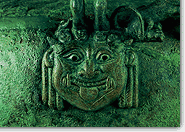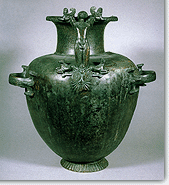





     | |
|
During the |  |
 |
However, the most important centre for Archaic toreutics was Corinth, both in the variety of shapes and decoration and in the wide spread of its products. Indeed the Corinthian metal vases travelled wherever the Greek went, from Colchis to Cumae in Italy and from the north Africa to the interior of the Balkans. The hydriai and the oinochoai often have the figures of kouroi and lions on their handles. On other occasions female busts or lion heads were placed exactly over the mouth of the vase, thus combining the function of the apotropaic symbol with its aesthetic presentation. The craters are another commercial success of the Corinthian artists of toreutics. They were often placed on a tripod and were decorated with relief of solid figures. They also manufactured beak-shaped prochous, two handled foot-bath, kadoi and phialai, whereas among the drinking vessels, the kotyle prevailed. In Peloponnese other workshops of toreutics also operated. The existence of the workshop in Olympia is certified -where craftsmen from various regions worked- whereas we assume that there were local workshops in the area of Sicyon and Aegium. |
In Macedonia the prevailing burial practices allowed the preservation of important examples of toreutics of the 6th century, that either came from the local workshops, or were imported from south and east Greece. Certain types that were formerly attributed to Peloponnesian workshops, such as the known "Argive" craters, seem, according to more recent researches, to be original, local creations. |
|
| |
|
Note: Click on picture for short description. | |